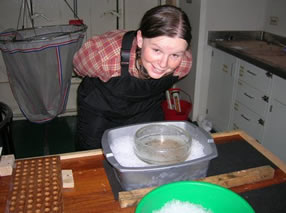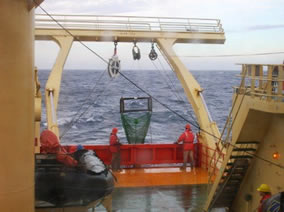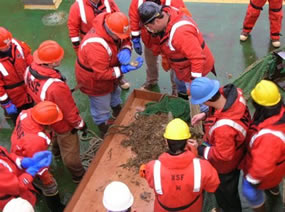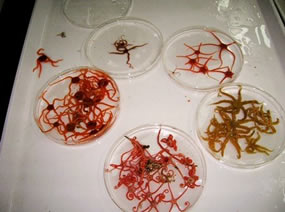
 |
| Academic Departments | Student Services | Alumni | Research | Outreach | Diversity |
| 1 | 2 | 3 | 4 | 5 | 6 | |
| 7 | 8 | 9 | 10 | 11 | 12 | 13 |
| 14 | 15 | 16 | 17 | 18 | 19 | 20 |
| 21 | 22 | 23 | 24 | 25 | 26 | 27 |
| 28 | 29 | 30 | 31 |
| 1 | 2 | 3 | ||||
| 4 | 5 | 6 | 7 | 8 | 9 | 10 |
| 11 | 12 | 13 | 14 | 15 | 16 | 17 |
| 18 | 19 | 20 | 21 | 22 | 23 | 24 |
| 25 | 26 | 27 | 28 | 29 | 30 |
Daily Journals
May 14, 2006
The ship was electric with anticipation this morning. The first net went over the side at about 0809, and at 1155, the ship headed to the next Station. Processing the first samples took another 4 hours. The Plankton Group was busier than bees in spring once that net was rinsed, and a glorious haul from the Blake dredge was unloaded about two hours later by the Benthics. The young academics were all out on deck awaiting that net. They looked like thoroughbreds at the post, or better yet, like kids on that special holiday morning where there are treat-laden, brightly knit stockings to be opened! Oooooooh, biiiiiig stocking!! In that delivery, there were sea stars, crabs, fish, worms, urchins, snails, squid and even a couple of very small octopi - enough to make everyone happy for at least a few hours. And so, it really begins. There, the groups are visually identified, photographed and some critters even give their lives to go on to further analysis in labs back home. The 80 degree-below freezer is the honored place of rest for those selected. The remainder go back over the side. Albatrosses have come into the picture today. These are the most graceful sea birds with a physiology just perfectly adapted to flying, mostly gliding, over miles and miles of ocean. To watch them is a pleasure and a comfort. If the wind and seas don't look calm to one's eye, these magnificent birds in flight create a completely different impression, and you must say to yourself, 'no, the conditions out here are just perfect'. Our work will be in the waters of Argentina in the direction of the Falkland Islands for the next couple of days. We will cycle several times through the plankton tows, bottom grabs, bottom (benthic) tows, water analyses and sorting, sorting, sorting before heading across the Drake Passage to the Antarctic Peninsula. I will continue to report back about the interesting things we see and do along the way.
So, don't hesitate to email questions to us at outreach@lmg.usap.gov
|
Longitude/Latitude: S-053 13.835 W-066 22.119 Temperature: 11.0 degrees Centigrade Wind: NNW at 22.8 km/h Menu: Roast beef, baked potatoes, Brussels sprouts, ratatouille, corn on the cob, fresh salad and rolls, and cake, cookies, and strawberries for dessert Photos:
This is a sorting of brittle stars
|
- Alabama Agricultural Experiment Station
- Alabama Cooperative Extension System
- Auburn Online Community
- Bookstore
- Center for Diversity
- Crisis/Incident Assistance
- Diversity and Multicultural Affairs
- Financial Aid
- Hotel and Conference Center
- Jule Collins Smith Museum of Fine Art
- Medical Clinic
- Southeastern Raptor Center
- Special Reports
- Students w/ Disabilities
- Theatre



